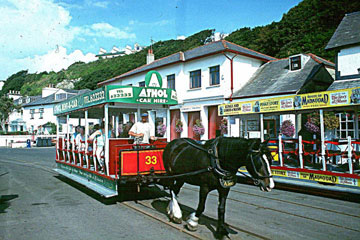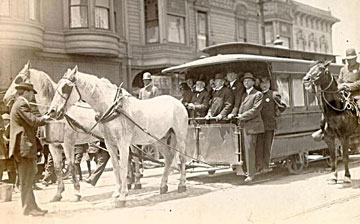|
|
Are At the Reins of the City’s Last Horsecar |
| The horses of San Francisco’s very last horsecar trip are being rewarded with a well-earned bucket of water after having completed an unusually long trip from the Ferry out Market Street to Valencia and then south on Valencia Street. The last horsecar URR No. 45 was a former Sutter Street Railway cable train trailer. Trailer No. 46, identical to No. 45, is on display at the Cable Car Museum as part of the Museum’s Sutter Street Railway cable car train display. |
|
LAST
HORSE CARS ARE DRIVEN BY ROLPH, CALHOUN
Mayor and U. R. R. President Take Part in Episode Historic in S.F.
SUPERVISORS
HELP AT TASK
Ancient Relics of Many Years' Service Go to the Barn at Last.
Editor’s Note: Before the 1906 Earthquake and Fire, Sutter Street
cable trains’ trailers were uncoupled from their grip (dummy) car
at Market Street to continue as a horse operation to the Ferry and back.
These horsecars used the outside tracks. Market Street cable cars used
the inside tracks. After the conflagration both the Sutter Street and
Market Street cable lines were electrified. The City because of antagonism
toward the URR refused to amend the outer track franchise to allow electric
cars. Thus, the URR continued a limited horsecar service to hold the franchise.
When the City opened its Geary Street streetcar lines in December 1912,
they asked the URR if they could use the outside tracks to reach the very
important Ferry Building. The City was refused. Ultimately, at a special
election the voters approved the "Lower Market Street Agreement."
Under this agreement both URR Sutter Street streetcars and the Geary cars
of the Municipal Railway could use the! lower Market Street outside tracks.
The City purchased a half interest in the tracks. The San Francisco
Examiner of June 4, 1913 describes San Francisco’s final horsecar
journey.
San Francisco is Horsecarless.
The last of the ancient relics that have been doing service on lower Market street was given its final drive yesterday, and promptly at noon the Sutter street electric cars were started down Market street to the ferries.
The event was made the motif of an impromptu celebration. Apparently everybody was happy. Mayor Rolph donned the driver's cap and drove the old horsecar from the ferries up Market street to Eighth. Then he gave way to Patrick Calhoun, president of the United Railroads, who was as ready to get rid of the antiquated type as the Mayor. Then Thornwell Mullally, assistant to Calhoun, took the reins.
After these officials had driven, a number of the Board of Supervisors helped make history for the city.
The car was filled with representatives of the municipal government and heads of the United Railroads Company, all equally elated, and the horses tugged and pulled at the unusual load.
AMAZEMENT FOR HORSES.
The horses left the ferries with their usual stolid air. They seemed disappointed when Sutter street was reached, and the usual stop was not made. And when mile after mile was added to the tiresome journey they became somewhat depressed. Usually the cars are hitched onto the rear of an electric car when the day's work is done and the horses are spared the long trip out to the end of Valencia street, and are stabled at a nearby barn. Yesterday this was all changed. Their work was over. Their mode of life was to be changed, and thereafter their usefulness will be directed into other channels.
The last ride up Market street took on the aspect of a triumphal procession. Lieutenant Matheson of the traffic squad was on hand and had four mounted officers to precede the car with a couple more to ride by the side of it. Camera men took snapshots, while a moving- picture concern followed and caught all there was of the spectacle.
Early yesterday morning Mayor Rolph took the necessary steps to banish the horse cars from the streets, following the action of the Board of Supervisors on Monday. He got into communication with the United Railroads, and arrangements were made that the last car would be driven up Market street from the ferries, the start to be made at 12 o'clock.
At the same hour the agreement between the company and the city regarding transfers at Fillmore and Divisadero streets also went into effect. From now on the United Railroads will transfer passengers to the Geary-street line, and the Municipal line will transfer to the United Railroads at these two points, the transfers being good in either direction. Later on, when the Geary-street road is completed to the ferries, transfers between the two systems will be given at Polk and Kearny streets. The city has the privilege of discontinuing transferring at these last two mentioned points if it finds the arrangement is not to its advantage. The United Railroads, according to the agreement entered into, has no such option.
SUPERVISORS ARE ON HAND.
As soon as the arrangements were made for the last trip, notice was sent to the various Supervisors and others. Supervisor Alexander Vogelsang, chairman of the public utilities committee, was on hand, as were a number of other Supervisors. Mayor Rolph, with his father, accompanied by Edward Rainey, the Mayor's secretary, also appeared promptly. A delegation from the Downtown Association, headed by A.G. McCarthy and Otto F. Schiller, was also there. President Calhoun, Thornwell Mullally, his assistant, and a number of citizens crowded onto the car until it was filled.
When the start was made Mayor Rolph exchanged his hat with J. H. Lee, the driver, who for thirty-two years has piled the old type of cars up and down the street. The Mayor took the reins and with a "giddap" the last journey was begun.
Lee, the driver, with Fred Thorp, his conductor, and Drive George Burrows and Conductor Tim O'Mera, of the alternating car, will be given assignments on some of the electric cars of the company and will report for their new duties to-day.
ARE CHEERED BY CROWDS.
As the old car proceeded up Market street driven by the Mayor, the crowds along the street caught the significance of the performance and cheered as it proceeded on its way. Few of the thousands who saw it were able to distinguish the Mayor or others who held the reins over the horses, but the sight of the horse car on upper Market street at the noon hour crowded with passengers, was sufficient to attract the crowds on the street and they knew what it meant.
When the horses got out to the end of the line they were completely fagged. The miles they had traveled did not affect them so much as the load they had been required to draw, and when the end of the journey was reached Mayor Rolph got a bucket and gave the animals a drink for their efforts.
The operation of the Sutter street cars down Market gave general satisfaction. The putting in of the new municipal crossing at that point had been finished and the cars took the trolley and swung down the street without trouble.
MASS MEETING FOR BONDS.
A meeting of the South Central Improvement Club will be held to-night at S. Joseph's Hall, 250 Tenth street, to discuss arrangements for a mass meeting to be held shortly to urge the adoption of the $3,500,000 bond issue for the extension of the municipal car lines. Delegates will be present from several south side clubs and a joint rally in favor of the bonds is planned.
Editor’s Note: YOU CAN STILL RIDE A HORSECAR!
| Douglas Horse Tramway "toastrack" No. 33 pulled by "Alec" is arriving at the line’s Derby Castle terminal where passengers will make the transfer to Manx Electric, July 29, 2000. On rainy days an enclosed "winter saloon" also provides service. |  |
Yes, you can still ride a horsecar other than at an amusement park. At Douglas, the capital and most important town of the Isle of Man (in the Irish Sea between England and Ireland), riders regularly use the Douglas Horse Tramway to connect with Victorian electric cars of the Manx Electric. The Douglas Horse Tramway operates a three-foot gauge, 1.6 mile double-track line from the terminal of Manx Electric (Derby Castle) to the City Center/Sea Terminal, running along Douglas’s sea-front Promenade. The horse tram, which except for war years, has operated since 1876.
On August 7, 2001, the tramway celebrated its 125th anniversary with a
cavalcade of trams along the Promenade. The seasonal service has thirty-six
tramcars (not all in service), including double deckers and 'toastracks'
and approximately sixty-eight horses. Each horse has its working day carefully
planned and will complete three round trips only per day. Once moving,
the trams move effortlessly on roller bearings, the horse merely trotting
along in front, giving the occasional pull to keep up momentum.
